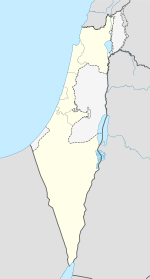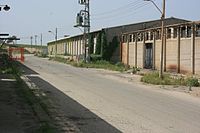- Ofakim
-
Ofakim Hebrew transcription(s) – Hebrew אֳפָקִים, אופקים – ISO 259 ʔopaqim – Also spelled Ofakim (unofficial) 
LogoCoordinates: 31°19′N 34°37′E / 31.317°N 34.617°ECoordinates: 31°19′N 34°37′E / 31.317°N 34.617°E District South Government – Type City – Mayor Zvika Greengold Area – Total 10,273 dunams (10.3 km2 / 4 sq mi) Population (2008)[1] – Total 24,800 Name meaning Horizons Ofakim (Hebrew: אֳפָקִים), (lit. "horizons") is a city in southern Israel, 20 kilometers west of Beersheba. It was founded as a development town on April 19, 1955. In 2008, Ofakim had a population of 24,800. The mayor is Zvika Greengold.[2]
Contents
History
Ofakim was established as a regional center for the rural communities in the area. The early residents were Jewish immigrants from North Africa and India.[2]
Demographics
In 2001, the ethnic makeup of the city was 99.7% Jewish and other non-Arab, with no significant Arab population. There were 11,200 males and 11,800 females – 41.8% 19 years of age or younger, 14.5% between 20 and 29, 18.5% between 30 and 44, 12.5% from 45 to 59, 3.6% from 60 to 64, and 9.1% 65 years of age or older. The population growth rate in 2001 was 0.6%.
About 30 percent of the residents are ultra-Orthodox, many of them newly observant. Another 30 percent are immigrants, mostly from the former Soviet Union. The rest are descendants of the founding generation, immigrants from North Africa and India who arrived in the town in the 1950s and 1960s. Ofakim also has a small community of Ethiopian Jews.[2]
Transport
Ofakim is linked to different cities in the nearby area by several bus routes, which are:
Route Destination Operator 30 Tze'elim <--> Be'er Sheva Egged Ta'avura 33 Be'er Sheva Egged Ta'avura 35 Eshcol Regional Council <--> Be'er Sheva Egged Ta'avura 365 Ashkelon Egged Ta'avura 372 (Only on weekends) Modi'in Illit Superbus 372 (Only on weekends) Tel Aviv NCBS Egged Ta'avura 376 Tze'elim <--> Tel Aviv Egged Ta'avura 490, 498 Bnei Brak Egged 494 Jerusalem CBS Egged Economy
In 2000, there were 5,655 salaried workers and 300 self-employed. The mean monthly wage for a salaried worker was NIS 3,728, a real change of 7.5% over the course of 2000. Salaried males had a mean monthly wage of NIS 4,761 (a real change of 10.1%) versus NIS 2,744 for females (a real change of 2.2%). The mean income for the self-employed was 4,776. There were 526 people receiving unemployment benefits and 3,538 receiving an income supplement.
As in other development towns, the industrial sector has historically played an important part in Ofakim's economy, but less so than in most other development towns. In 1972, 32% of the salaried workers (754 people) were in this sector, and in 1983—924 people (23%). During this period, the textile industries consistently employed by far the most workers, ranging from 72% (1982–83) to 82% (1972). The Of–Ar (short for Ofakim–Argentina) textile factory was a major employer.[3]
Education
There are 19 schools and 4,704 students in the city – 13 elementary schools (3,079 students), and 8 high schools (1,625 students). 43.3% of 12th grade students were entitled to a matriculation certificate in 2001.
Sports
One of Israel's 14 tennis centers is located in Ofakim.[4] It opened in 1990 and has six courts. The city also has a soccer stadium.
Development plans
A train station opened in 2010 with a car park for 1,000 cars, and an old industrial building is being converted into an art museum.[2] The Nahal Shomriya cycling route around Ofakim was inaugurated in 2010. The 60-centimeter-wide single route winds through 1,500 dunams (approx 375 acres) in Ofakim Forest, passing through Nahal Shomriya and Nahal Patish, and looping around eight local moshavim.[5]
References
- ^ "Table 3 - Population of Localities Numbering Above 2,000 Residents and Other Rural Population". Israel Central Bureau of Statistics. 2009-09-30. http://www.cbs.gov.il/population/new_2010/table3.pdf. Retrieved 2010-06-22.
- ^ a b c d New Horizons for Ofakim
- ^ Schwarz, Dafna (2009). "Industrialization Attempts in Three Development Towns: Ofakim, Migdal HaEmek and Ma'alot". In Halamish, Aviva; Meir-Glitzenstein, Esther; Tzameret, Zvi. The Development Towns. Idan Series Vol. 24. Yad Yitzhak Ben Zvi. pp. 160–162. ISBN 978-965-217-298-3. (Hebrew)
- ^ Tennis doubles coexistence program
- ^ Riding and Building New Ofakim - Shomriya Cycling Route
External links
South District of Israel Cities 
Local councils Ar'arat an-Naqab · Hura · Kuseife · Lakiya · Lehavim · Meitar · Mitzpe Ramon · Omer · Shaqib al-Salam · Tel as-Sabi · YeruhamRegional councils Abu Basma · Be'er Tuvia · Bnei Shimon · Central Arava · Eshkol · Hevel Eilot · Hof Ashkelon · Lakhish · Merhavim · Ramat HaNegev · Sdot Negev (Azata) · Sha'ar HaNegev · Shafir · Tamar · YoavSee also Other sub-divisions: Center District · Haifa District · Jerusalem District · Judea and Samaria Area · North District · Tel Aviv DistrictCategories:- South District (Israel)
- Cities in Israel
- Development towns
Wikimedia Foundation. 2010.






